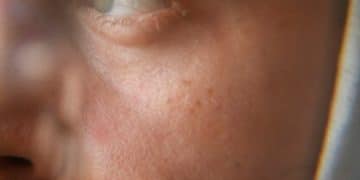Diet & Skincare: 5 Foods for Clearer Skin in 2025

The strong link between dietary choices and skin health is increasingly recognized, with specific foods offering nutrients that can significantly contribute to a clearer and healthier complexion by 2025, moving beyond topical treatments to address skin concerns from within.
In the quest for flawless skin, countless products promise miraculous transformations. Yet, a growing body of evidence, bolstered by dermatological research, increasingly points towards a fundamental truth: the path to a radiant complexion often begins not in a tube or a bottle, but on our plates. This article delves into the role of diet in skincare: 5 foods to eat for clearer skin in 2025, exploring how specific nutritional choices can profoundly influence skin health, clarity, and overall appearance, offering a holistic approach to beauty that extends far beyond surface-level treatments.
The Gut-Skin Axis: Understanding the Connection
The human body is an intricate network, and few connections are as profound as the “gut-skin axis.” This concept highlights how the health of our digestive system directly influences the condition of our skin. When our gut microbiome – the trillions of bacteria residing in our intestines – is balanced and thriving, it can positively impact the skin. Conversely, an imbalance, often referred to as dysbiosis, can lead to systemic inflammation, which frequently manifests as skin issues like acne, eczema, and psoriasis.
This intricate connection means that what we consume acts as the primary fuel for our gut microbiome. A diet rich in processed foods, unhealthy fats, and excessive sugar can disrupt this delicate balance, fostering the growth of harmful bacteria and diminishing beneficial ones. This disruption can then trigger inflammatory responses throughout the body, with the skin often serving as a visible indicator of internal distress. For example, studies have shown that chronic inflammation can break down collagen and elastin, leading to premature aging and a dull complexion.
Inflammation’s Impact on Skin Health
Inflammation is a natural bodily response to injury or infection, but chronic low-grade inflammation, often fueled by poor dietary habits, can damage healthy cells and tissues. In the context of skin, this persistent inflammation shows up as redness, swelling, and breakouts. It can exacerbate conditions like acne by stimulating excess sebum production and increasing bacterial growth within pores. For individuals prone to rosacea, inflammatory foods can trigger flare-ups, leading to persistent facial redness and visible blood vessels. Furthermore, inflammatory processes can impair the skin’s barrier function, making it more susceptible to environmental aggressors and moisture loss.
- Chronic inflammation accelerates aging by degrading collagen.
- It can trigger or worsen conditions like acne and eczema.
- Impaired skin barrier function leads to dryness and sensitivity.
- Dietary choices are key in managing systemic inflammation.
The Role of Microbiome Balance
A diverse and healthy gut microbiome produces beneficial compounds, such as short-chain fatty acids (SCFAs), which have powerful anti-inflammatory properties. These SCFAs not only support gut integrity but also circulate throughout the body, influencing immune responses and reducing inflammation in various organs, including the skin. A balanced microbiome also helps in the absorption of essential nutrients vital for skin health, such as vitamins, minerals, and antioxidants. When the microbiome is thriving, it can enhance the skin’s natural defense mechanisms, making it more resilient to environmental stressors like pollution and UV radiation. Maintaining a robust gut ecosystem through diet is thus a proactive step towards achieving and sustaining clear, healthy skin.
Food 1: Avocado – The Healthy Fat Powerhouse
Avocado has emerged as a superstar in the world of nutrition, not just for its creamy texture and versatility, but for its profound benefits to skin health. Often lauded as a “healthy fat powerhouse,” avocado is rich in monounsaturated fatty acids, particularly oleic acid, which are crucial for maintaining skin hydration and elasticity. These healthy fats are essential components of cell membranes, helping to keep them strong and flexible, which in turn contributes to a supple and resilient skin barrier.
Beyond its fat content, avocado is packed with a spectrum of vitamins and antioxidants vital for combating skin damage and promoting a clear complexion. It’s an excellent source of Vitamin E, a potent antioxidant that protects the skin from oxidative stress caused by free radicals—unstable molecules that can damage skin cells and accelerate aging. It also contains Vitamin C, which is pivotal for collagen production, the structural protein that gives skin its firmness and elasticity. The combination of these nutrients makes avocado an anti-aging and skin-protective superfood.
Key Skin Benefits of Avocado
The unique nutritional profile of avocados offers several compelling benefits for achieving clearer skin. Its high fat content doesn’t clog pores; instead, it provides the necessary lipids to support the skin’s natural barrier. This barrier is essential for locking in moisture and keeping out irritants and pollutants. When the skin barrier is compromised, it can lead to dryness, sensitivity, and greater susceptibility to inflammatory conditions that cause breakouts.
* Deep Hydration: Monounsaturated fats help retain skin moisture.
* Antioxidant Protection: Vitamins E and C combat free radical damage.
* Collagen Support: Vitamin C aids in collagen synthesis.
* Reduced Redness: Anti-inflammatory compounds can soothe irritated skin.
* Enhanced Elasticity: Healthy fats contribute to skin suppleness.
Incorporating avocado into your diet can be a simple yet effective strategy for enhancing skin health from within. Whether it’s added to salads, blended into smoothies, or simply enjoyed on toast, its regular consumption can contribute noticeably to a more hydrated, protected, and ultimately clearer complexion.
Food 2: Berries – Antioxidant Superstars
Berries, those vibrantly colored fruits, are celebrated not just for their delicious taste but for their remarkable health benefits, especially when it comes to skin. They are truly antioxidant superstars, brimming with anthocyanins, ellagic acid, and resveratrol. These powerful compounds are essential in the fight against oxidative stress, a primary contributor to skin aging and various dermatological issues. Oxidative stress occurs when there’s an imbalance between free radicals and antioxidants in the body, leading to cellular damage. By neutralizing free radicals, the antioxidants in berries help protect skin cells from damage, preserving their health and function.
The high concentration of Vitamin C in berries further elevates their status as skin-supporting foods. Vitamin C is indispensable for collagen synthesis, the process by which our body produces collagen. As we age, collagen production naturally declines, leading to wrinkles and sagging skin. By providing a rich source of this vital vitamin, berries help maintain skin elasticity and firmness, contributing to a smoother and more youthful appearance. Furthermore, Vitamin C enhances the skin’s natural repair processes, aiding in the healing of blemishes and minor abrasions.
Variety of Berries and Their Unique Benefits
While all berries are beneficial, different types offer unique profiles of antioxidants and nutrients, making a diverse intake particularly advantageous for comprehensive skin care.
- Blueberries: Particularly rich in anthocyanins, which give them their deep blue hue. These antioxidants are known for their anti-inflammatory properties and ability to improve microcirculation, delivering more nutrients to skin cells.
- Strawberries: High in Vitamin C, even more so than oranges in some cases. They also contain ellagic acid, which is believed to help prevent collagen destruction and protect against UV damage.
- Raspberries: A good source of fiber and ellagic acid, providing similar collagen-protecting and UV-defense benefits to strawberries. Their high antioxidant content helps reduce skin inflammation.
- Blackberries: Loaded with vitamins C and K, and high in antioxidants. They contribute to skin regeneration and help maintain a healthy skin barrier.
Regular consumption of a variety of berries can significantly boost the skin’s resilience against environmental damage, reduce inflammation, and support its natural regenerative processes. Whether fresh, frozen, or incorporated into meals and snacks, berries are an easy and delicious way to infuse your diet with skin-loving nutrients, moving towards a clearer, more vibrant complexion in 2025.
Food 3: Fatty Fish – Omega-3 Elixir
Fatty fish, such as salmon, mackerel, and sardines, are celebrated as an “omega-3 elixir” due to their exceptionally high content of omega-3 fatty acids, specifically EPA (eicosapentaenoic acid) and DHA (docosahexaenoic acid). These essential fatty acids are not produced by the body, meaning we must obtain them through our diet. When it comes to skin health, omega-3s are truly foundational, playing a critical role in maintaining the integrit y and function of skin cell membranes. They contribute to a healthy lipid barrier, which is crucial for retaining moisture and keeping skin hydrated and plump, thus reducing the appearance of fine lines and a dull complexion.
Beyond hydration, the anti-inflammatory properties of omega-3s are perhaps their most significant contribution to clearer skin. Chronic inflammation is a major underlying factor in many skin conditions, including acne, eczema, and psoriasis. EPA and DHA help to modulate the body’s inflammatory response, reducing redness, swelling, and irritation that often accompany these conditions. By calming systemic inflammation, omega-3s can prevent breakouts and improve the overall texture and tone of the skin, lending it a smoother and more even appearance.
Role in Reducing Inflammation and Maintaining Healthy Skin Barrier
The mechanism by which omega-3s exert their anti-inflammatory effects is complex but highly effective. They compete with omega-6 fatty acids (often found in processed foods and vegetable oils) for enzyme pathways that produce inflammatory molecules. By shifting the balance towards anti-inflammatory mediators, omega-3s can significantly dial down the body’s inflammatory cascade. This has a direct benefit for the skin, particularly for those suffering from inflammatory skin conditions. For instance, individuals with severe acne characterized by cystic lesions often experience a reduction in both the severity and frequency of breakouts when they increase their intake of omega-3s.

Furthermore, omega-3s strengthen the skin’s natural barrier function. This barrier is a protective layer that shields the skin from environmental aggressors, irritants, and allergens, while simultaneously preventing moisture loss. A robust skin barrier is essential for maintaining hydration and preventing issues like dryness and sensitivity. When the barrier is compromised, skin can become vulnerable to external threats, leading to inflammation and breakouts. Regular consumption of fatty fish helps rebuild and fortify this barrier, making the skin more resilient and less prone to irritation. In essence, incorporating fatty fish into your diet acts as an internal moisturizer and anti-inflammatory agent, paving the way for clearer, more resilient skin.
Food 4: Leafy Greens – The Detoxifying Powerhouse
Leafy greens, such as spinach, kale, and Swiss chard, are often heralded as a “detoxifying powerhouse” due to their rich concentration of vitamins, minerals, and antioxidants that are vital for overall health and, specifically, for cultivating clearer skin. These greens are packed with chlorophyll, a natural pigment known for its potential to cleanse the blood and flush out toxins, which can otherwise manifest as dullness or breakouts on the skin. Beyond chlorophyll, they are abundant in vitamins A, C, E, and K, along with important minerals like iron and magnesium, all of which play distinct roles in maintaining skin health.
Vitamin A, for instance, is crucial for cell turnover and repair, promoting the shedding of old skin cells and the generation of new, healthy ones. This process helps prevent clogged pores and reduces the likelihood of acne. Vitamin C, as discussed, is essential for collagen production and antioxidant protection. Vitamin E works in synergy with C to provide a robust defense against oxidative stress. Together, these nutrients form a formidable team, not only protecting the skin from environmental damage but also contributing to its regeneration and repair, leading to a visibly clearer and more vibrant complexion.
Specific Nutrients and Their Skin Benefits
The broad spectrum of nutrients found in leafy greens offers a holistic approach to skin care, addressing multiple concerns simultaneously.
* Chlorophyll: Believed to have detoxifying properties, aiding in the removal of impurities from the body, which can correlate with reduced breakouts and a brighter skin tone.
* Antioxidants (Vitamin A, C, E): Combat free radical damage, protecting skin cells from premature aging and reducing inflammation. They contribute to skin’s resilience against environmental pollutants and UV radiation.
* Folate: Essential for DNA synthesis and repair, supporting healthy cell division and promoting skin regeneration.
* Fiber: Promotes a healthy digestive system, facilitating regular bowel movements and toxin elimination. A healthy gut reflects positively on skin clarity, reinforcing the gut-skin axis.
* Water Content: While often overlooked, the high water content in leafy greens contributes to overall hydration, which is fundamental for plump, supple skin.
Regularly incorporating a variety of leafy greens into your diet, whether through salads, smoothies, or cooked dishes, can significantly bolster your skin’s natural defenses and regenerative capabilities. By providing essential nutrients that support detoxification and cellular health, leafy greens pave the way for a clearer, healthier, and more luminous complexion.
Food 5: Nuts and Seeds – Mineral and Essential Fatty Acid Sources
Nuts and seeds may be small, but they are mighty powerhouses of nutrition, particularly when it comes to supporting skin health. They serve as exceptional sources of vital minerals and essential fatty acids, making them indispensable components of a diet aimed at achieving clearer skin. Specifically, pumpkin seeds, sunflower seeds, almonds, and walnuts stand out for their rich profiles of zinc, selenium, vitamin E, and omega-3 fatty acids, all of which play critical roles in maintaining skin integrity and function.
Zinc, found abundantly in pumpkin seeds and cashews, is a mineral crucial for wound healing, reducing inflammation, and regulating sebum production. Its anti-inflammatory properties can be particularly beneficial for those prone to acne, as it helps calm existing breakouts and prevents new ones. Selenium, present in Brazil nuts and sunflower seeds, is a powerful antioxidant that works in synergy with Vitamin E to protect skin cells from oxidative damage, which can lead to premature aging and a dull complexion. The essential fatty acids, such as those in walnuts (omega-3s) and sunflower seeds (omega-6s), are fundamental for building healthy cell membranes, preserving the skin’s natural barrier, and maintaining hydration.
How Specific Nuts and Seeds Contribute to Skin Clarity
Each type of nut and seed brings its own unique set of benefits to the table, making a diverse intake highly advantageous for comprehensive skin health.

* Almonds: Rich in Vitamin E, offering potent antioxidant protection against UV damage and environmental pollutants. They also contain magnesium, which is important for managing stress levels, a known trigger for skin conditions.
* Walnuts: Unique among nuts for their high content of omega-3 fatty acids, similar to those found in fatty fish. These contribute significantly to reducing inflammation and improving skin barrier function, leading to a more supple and clear complexion.
* Pumpkin Seeds: An excellent source of zinc, vital for regulating oil production and aiding in skin repair. They also contain antioxidants and magnesium, further supporting skin health and reducing inflammation.
* Sunflower Seeds: Abundant in Vitamin E, along with selenium and copper. Vitamin E provides antioxidant protection, while copper aids in collagen and elastin production, preserving skin elasticity.
* Flaxseeds and Chia Seeds: While not traditionally “nuts,” these seeds are packed with alpha-linolenic acid (ALA), a plant-based omega-3 fatty acid. They also offer high fiber content, supporting gut health, which, as established, is intrinsically linked to skin clarity.
Incorporating a handful of diverse nuts and seeds into your daily diet—whether in smoothies, sprinkled over salads, or as a standalone snack—provides a concentrated dose of essential nutrients. This consistent intake can lead to noticeable improvements in skin clarity, resilience, and overall radiance, making them a cornerstone of any skin-healthy eating plan in 2025 and beyond.
Building a Skin-Friendly Diet: Practical Tips for 2025
Integrating skin-friendly foods into your daily routine doesn’t have to be complicated. The key is consistency and a focus on whole, unprocessed foods that nourish your body from the inside out. Shifting your diet to prioritize skin health means moving away from heavily processed items, sugary snacks, and excessive consumption of refined carbohydrates, all of which can trigger inflammatory responses that negatively impact your complexion. Instead, aim to build meals around the five food groups discussed – avocados, berries, fatty fish, leafy greens, and nuts/seeds – complemented by other nutrient-dense options.
One of the most effective strategies is to adopt a mindset of conscious eating, where you actively choose foods that you know benefit your skin. This might involve meal prepping to ensure you always have healthy options on hand, or making small, manageable changes over time rather than attempting an overnight overhaul. Small adjustments, consistently applied, often lead to more sustainable habits and long-term results.
Beyond the Plate: Hydration and Lifestyle Factors
While the spotlight is often on the foods we eat, achieving clear skin in 2025 demands a holistic approach that extends beyond just diet. Hydration is paramount; water is essential for countless bodily functions, including maintaining skin elasticity, flushing out toxins, and ensuring proper nutrient delivery to skin cells. Aim for adequate water intake throughout the day, as even mild dehydration can make your skin look dull and accelerate the appearance of fine lines.
- Prioritize Water: Drink plenty of water daily to maintain skin hydration and detoxification.
- Manage Stress: Chronic stress can trigger hormonal imbalances and inflammation, affecting skin health. Incorporate stress-reducing activities like meditation or yoga.
- Adequate Sleep: Skin regenerates and repairs itself during sleep. Aim for 7-9 hours of quality sleep per night.
- Sun Protection: While diet helps, topical sun protection remains crucial for preventing UV damage and premature aging.
- Limit Harmful Foods: Reduce intake of processed foods, refined sugars, and excessive dairy, which can exacerbate skin issues for some individuals.
Consistency in these lifestyle factors complements dietary changes, creating a synergistic effect that promotes optimal skin health. By nurturing your body with the right foods, staying hydrated, managing stress, getting enough sleep, and protecting your skin from external aggressors, you build a comprehensive strategy for achieving and maintaining a clear, radiant complexion from within. This holistic approach ensures that your skin reflects your overall well-being, paving the way for lasting results.
| Key Food | Skin Benefit |
|---|---|
| 🥑 Avocado | Healthy fats for hydration and elasticity. |
| 🍓 Berries | Antioxidants combat free radicals, boost collagen. |
| 🐟 Fatty Fish | Omega-3s reduce inflammation and strengthen skin barrier. |
| 🥬 Leafy Greens | Detoxify and provide key vitamins for cell regeneration. |
Frequently Asked Questions About Diet and Skin
Results vary person-to-person, but noticeable improvements often begin within 4-12 weeks of consistent dietary changes. Skin cell turnover takes time, so patience is key. Initial changes might include reduced inflammation or better hydration, while more significant improvements in clarity can take longer as the body adjusts and regenerates.
While diet plays a significant role in managing and reducing acne, especially inflammatory types, severe acne often benefits from a multi-faceted approach. Dietary changes can greatly complement topical treatments and, in some cases, prescribed medications. Consulting a dermatologist for personalized advice is always recommended for severe conditions.
Common culprits often include highly processed foods, sugary drinks, excessive refined carbohydrates (white bread, pasta), and sometimes dairy, which can trigger inflammation and exacerbate breakouts in sensitive individuals. Observing how your skin reacts to these foods can help identify specific triggers for your body.
While some supplements can support skin health (e.g., omega-3s, zinc), they typically don’t replicate the full spectrum of nutrients, fiber, and synergistic benefits found in whole foods. Foods provide a complex matrix of compounds that work together more effectively. Supplements are best used to complement, not replace, a balanced diet.
Some proponents suggest intermittent fasting can improve skin clarity by reducing inflammation and supporting cellular repair processes like autophagy. However, research is still evolving, and its effects can vary among individuals. It’s crucial to ensure nutritional needs are met during eating windows and to consult a healthcare professional before starting any new dietary regimen.
Conclusion
The profound connection between our diet and the health of our skin is undeniable and increasingly paramount in the pursuit of a clear, radiant complexion. As we look towards 2025, it’s clear that true skincare extends far beyond topical applications, rooting itself firmly in the nourishing power of whole foods. By consciously incorporating nutrient-dense choices like avocados, berries, fatty fish, leafy greens, and nuts and seeds, we provide our bodies with the essential building blocks, antioxidants, and anti-inflammatory compounds necessary to support skin health from within. This holistic approach, combined with healthy lifestyle choices such as proper hydration, stress management, and adequate sleep, empowers us to cultivate not just clearer skin, but a deeper sense of overall well-being. Embracing this internal shift towards mindful eating is a powerful step towards unlocking your skin’s full potential.





